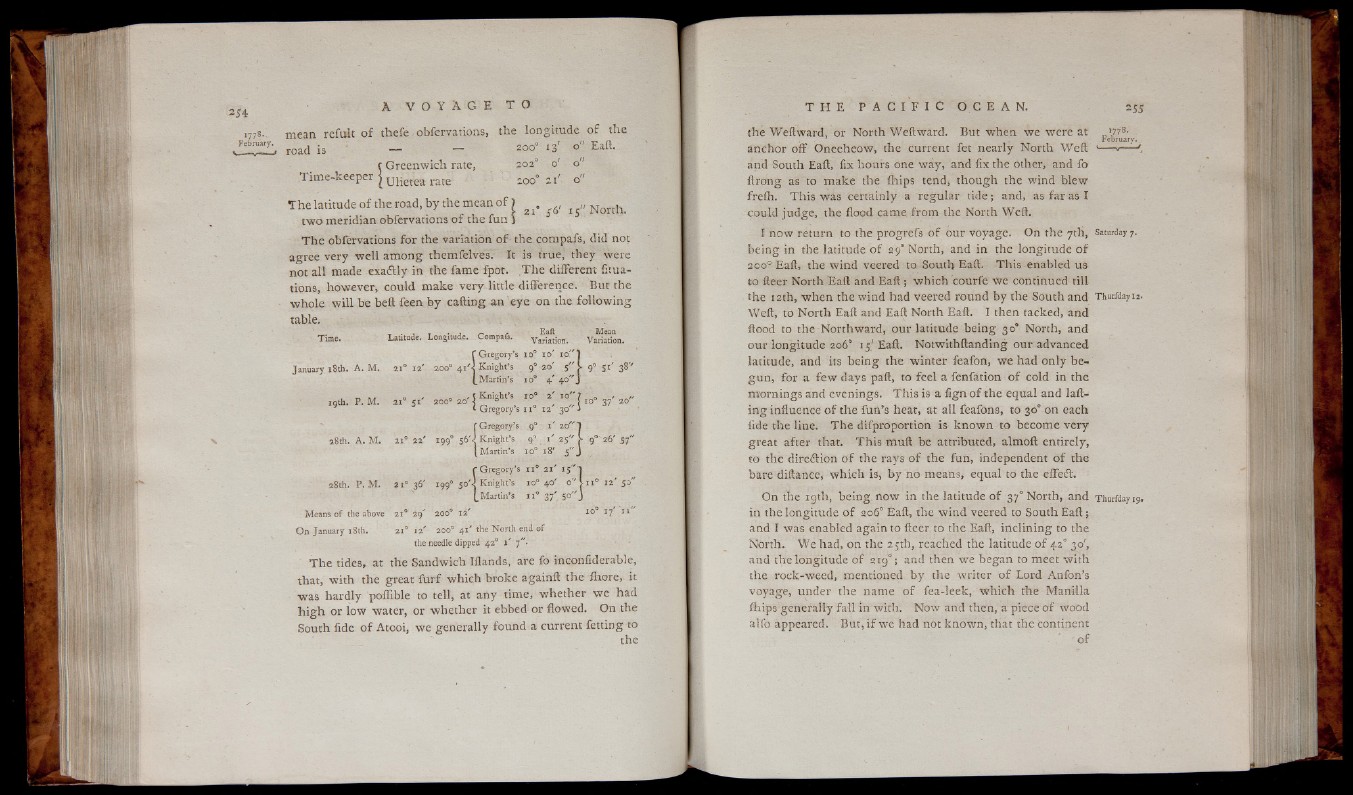
1778-, mean refult o f thefe obfervations, the longitude o f the
¿ « r o a d is J - - 200“ 13' °"Eaft.
f Greenwich rate, 202° o' o"
T ime-k eep er | u lie te a rate 200° 21' o"
T h e latitude o f the road, b y the mean o f ) ■ i S" North,
two meridian obfervations o f the fun )
T h e obfervations fo r the variation o f the compafs, did not
agree very w e ll among themfelves.' It is true, they were
not all made e x a ftly in the fame fpot. T h e different fituations,
however, could make v e ry little difference. But the
w ho le w ill be beft feen b y ca llin g an eye on the fo llow in g
table.
, . , T • j r Eaft Mean
Tune. Latitude. Longitude. Compafi. Variation; Variation.
f Gregory’s io ° i o ' 10^ 1
January 18th. A .M . 2 1 ° 12 ' 200° 4 1 ^ Knight’ s 90 W 5 " > 90 5 1 ' 38'*
(_ Martin’s io ° 4 ' 40 " J
— — t o / o ' V Knight’s io ° 2 ' 10''7 0 / „ «
19th. P .M . 2 10 5 1 200° 20 j 5 \ m m \ io ° 37 20
* Gregory s n ° 12 30 J
f G regory’s 90 1 ' 20" 1
28th. A .M . 21° 2 2 ' 199° 5 6 'J Knigh t’s 9 \ i ' 2s ' ' j- 90 26' 5 7 "
I Martin’s ip ° 18' 5r'J
r Gregory’ s n ° 2 1 ' I 5 " j
28th. P .M . 2 1 0 36' 1 990 5 0 '! Knight’ s io ° 40' o " t n ° 1 2 '5 0 ^
(_ Martin’ s n ° 37', 50 j
Means o f the above 210 29' 200° 12 ' 10 17 11
O n January 18th. 210 1 2 ' 200° 4 1 ' the North end o f
the needle dipped 420 i / ’]"*
T h e tides, at the Sandwich Iflands, are fo inconfiderable,
that, with the great fu r f which broke againft the ihore,. it
was hardly poffible to tell, at any time, whether w e had
h ig h or low water, or whether it ebbed or flowed. On the
South fide o f Atooi, we generally found a current fetting to
the
the Weftward. or North Weftward. But when we were at ’ 77s-
F eb rua ry.^
anchor off Oneeheow, the current fet nearly North Weft 1— »——C
and South Eaft, fix hours one way, and fix the other, and fo
ftrong as to make the {hips tend, though the wind b lew
frefh. This was certainly a regu lar tid e ; and, as far as I
Could ju d g e, the flood came from the North Weft.
I now return to the progrefs o f our voyage. On the 7th, Saturday;,
being in the latitude o f ay* North, and in the longitude o f
200° Eaft, the wind veered to South Eaft. This enabled us
to fleer North Eaft and Eaft ; w hich courfe w e continued till
the 12th, when the wind had veered round by the South and TKuufdayia.
Weft, to North Eaft and Eaft North Eaft. I then tacked, and
flood to the Northward, our latitude b e in g 30° North, and
our longitude 206° 15' Eaft. Notwithftanding our advanced
latitude, and its being the winter feafon, we had only begu
n , for a few days paft, to fe e l a fenfation o f cold in the
mornings and evenings. This is a fign o f the equal and Iaft-
in g influence o f the fun ’s heat, at all feafons, to 30° on each
fide the line. T h e difproportion is kn own to become v e ry
great after that. T h is mull be attributed, almoft entirely,
to the direction o f the rays o f the fun, independent o f the
bare diftanee, w hich is, b y no means, equal to the effeft.
On the 19th, being now in the latitude o f 37° North, and Thurfday 19.
in the longitude o f 206° Eaft, the wind veered to South E a ft;
and I was enabled again to fleer to the Eaft, iriclining to the
North. We had, on the 25th, reached the latitude o f 42° 30',
and the longitude o f 219°; and then we began to meet w ith
the roek-weed, mentioned b y the writer o f Lord Anfon’s
voyage, under the name o f fea-leek, w h ich rhe Manilla
fhips generally fall in with. Now and then, a piece o f wood
alfo appeared. But, i f w e had not known, that the continent
o f